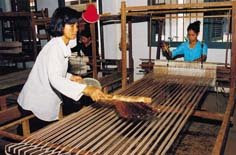
Words and photographs by Moeun Nhean Cambodian farmers make traditional Krama all throughout the kingdom but for day tripping, it may convenient to visit several interesting places such as Pea-ream and Thnoat communes in Bati district, and Tang Yab and Say-va commune in the Samrong district of Takeo province. Or go to Prek Chang-kran commune, Sithor Kandal district of Prey Veng province, but the closest Krama makers are on Koh Dach village-island.
Koh Dach village, well know as a ‘weaving handicraft village,’ is on one of the largest islands located on the Upper Mekong, with a length of 12 kilometres. The island is located in Koh Dach commune, Mukh Kampool district. Koh Dach is about 10 kilometres from Phnom Penh.
The Koh Dach villagers have retained their traditional lifestyle based around their main handicraft, traditional silk weaving, Pha-muong, Hol, Krama and cotton clothes. Visitors walking the villager trail around the island will hear the sound of looms emerging from every house. Some houses have 5-10 looms and all the family members are weavers. From eight to eighty years of age, all the family play a role in production. As a result, much of the silk, Pha-muong, Hol and Kramar products for sale in the Phnom Penh markets originated in the Koh Dach villages, all of it hand made and of fine quality.
The Koh Dach villagers have retained their traditional lifestyle based around their main handicraft, traditional silk weaving, Pha-muong, Hol, Krama and cotton clothes. Visitors walking the villager trail around the island will hear the sound of looms emerging from every house. Some houses have 5-10 looms and all the family members are weavers. From eight to eighty years of age, all the family play a role in production. As a result, much of the silk, Pha-muong, Hol and Kramar products for sale in the Phnom Penh markets originated in the Koh Dach villages, all of it hand made and of fine quality.
Beside the production of handicrafts, the residents of Koh Dach are also excellent gardeners, producing a wide variety of seasonal vegetables and fruits. The geography of Koh Dach Island varies. Though 12 kilometres long, some areas are only 100 meters wide and 2,500 meters wide elsewhere. The land is home to thousands of Khmer traditional houses and three ancient pagodas, each with a long history set in a traditional context. A visit to Koh Dach will give you a better understanding of Cambodian life than any other area surrounding the capital. You will take away lasting memories of the arts and lives of Cambodian people, happily co-existing with nature and traditional values.

No comments:
Post a Comment